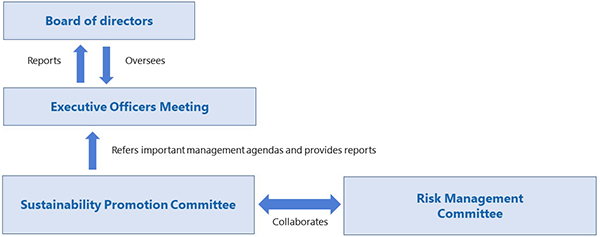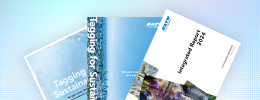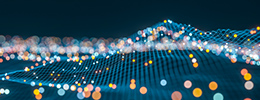At the SATO Group, we recognize that climate change profoundly impacts our world and that it is critical for us to act on climate issues in managing our business. In 2021, we declared our support for the Task Force on Climate-related Financial Disclosures (TCFD) and started applying TCFD recommendations to our climate actions.
Basic stance
Sustainability is inseparable from our business, as is made clear right in our corporate mission to “create new value for our customers through products and services of superior quality, and to contribute towards a better and more sustainable world.”
While our basic policy for sustainability was only set forth in 2018, we have long positioned sustainability as the cornerstone of company management.
To ensure we contribute to a low-carbon society while seeking higher corporate value, we focus on two aspects.
- (1)Help customers lower their greenhouse gas emissions with our value-added solutions that improve productivity.
- (2)Make systematic efforts to reduce greenhouse gas emissions linked to our operations, enhance green procurement practices and expand recycling options.
(See “4. Metrics and targets” for how we track our progress in reducing emissions.)
In driving our sustainability initiatives, we worked to identify issues that are material for our business and stakeholders in three areas — A. Our value proposition, B. Fundamentals of our value creation, and C. Environmental responsibility — and are taking the following actions to address climate change in each area.
- A. Our value proposition:
- Offer eco-friendly products; help customers reduce greenhouse gas emissions with our solutions
- B. Fundamentals of our value creation:
- Engage with suppliers to drive sustainable procurement
- C. Environmental responsibility:
- Install solar power systems, shift to renewable energy sources, participate in tree planting activities, and optimize production and logistics processes
We will enhance the quality and quantity of information we disclose by continuing climate scenario analysis, which we started based on TCFD recommendations. We will also strive to improve our sustainability performance for greater social and business value.
Climate-related disclosure, guided by TCFD principles
1. Governance
We aspire to play an essential role in society by delivering solutions that create value and address customer pain points on an ever-wider scale to continuously meet the needs of the times. Looking toward this 2030 vision, we unveiled our new medium-term management plan in FY 2024. One focus of the plan is on reinforcing business fundamentals, which requires increasingly sustainable business practices such as strengthening corporate governance and human capital management and reducing emissions.
The Sustainability Promotion Committee, which reports directly to our Executive Officers Meeting, works on driving climate and environment action, green procurement and other sustainability priorities across the SATO Group. Led by our executive officer for sustainability and overseen by our board of directors, the committee comprises members from corporate planning and key business divisions to ensure we infuse sustainability into our business growth efforts.
The committee will refer those matters that may significantly impact business strategies and management plans to the Executive Officers Meeting, providing reports and deliberation outcomes to facilitate top-level decision-making at the meeting. It also regularly reports on the progress of its activities to our board of directors via the said meeting, which is chaired by our President and Group CEO, who also serves as our top executive for climate action.
Climate change governance at SATO

2. Strategy
With the help of external advisers, our Sustainability Promotion Department has been using the climate scenario analysis since FY 2021 to define scenarios of potential future climate states, assess the impact of climate-related risks and opportunities on our business and financial forecast under each scenario, and identify actions to manage these risks and opportunities.
Under the following two, publicly available scenarios based on information from the International Energy Agency and other sources, we developed two views on the medium and long term (2030 and 2050) future of our AIDC (automatic identification and data capture) industry and key sectors our customers operate in.
- 1.5°C scenario aligned with the Paris Agreement:
A scenario whereby efforts for sustainable development are effective at limiting the increase in the global average temperature to at most 1.5°C above pre-industrial levels - 4.0°C “too little, too late” transition scenario:
A scenario whereby the world falters on serious climate action, resulting in the global average temperature rising by some 4.0°C compared to pre-industrial levels
We determined that we will be able to operate in our industry with resilience under both scenarios. In the first scenario, this requires that we decarbonize our business model at an increasing speed to adapt to new carbon taxes and soaring raw material prices amid massive advancements in decarbonization policies. In the second scenario, we must make sure to manage physical risks that cause business interruption and damage across our operations and supply chains to avoid costly consequences.
Examples of our future scenarios
The 1.5°C scenario presents substantial risks associated with rising production costs as businesses compete for critical energy minerals, recyclable materials and fast-depleting forest resources. But it also creates demand for eco-friendly products/solutions and reliable traceability systems that underpin the circular economy, bringing huge opportunities for our tagging technology and business.
The 4.0°C scenario, on the other hand, carries physical and business continuity risks arising from extreme weather events and climate hazards, which increase costs significantly for our operations.
As our mission is to contribute towards a better and more sustainable world, we will pursue measures to meet the first scenario but also plan for the second from risk management perspectives.
Actions we can take to manage risks, as identified from our climate scenario analysis, include cutting our greenhouse gas emissions further, building a socially responsible procurement framework and strengthening business continuity planning within our supply chains.
Possible actions for managing related opportunities, on the other hand, center on delivering value to customers and the society through, for example, developing and offering more eco-friendly products/solutions and expanding business for data collection or utilization.
Our assessment of climate-related risks and opportunities, with potential actions identified
3. Risk management
We identify risks through the climate scenario analysis, using climate parameters and assumptions (such as those related to policy changes) that we update regularly to evaluate how these climate-related risks can quantitatively impact the company's business and financial position.
Risk evaluations are reported to not only the Executive Officers Meeting but also the board of directors to ensure that processes for managing climate-related risks are integrated into the company's overall risk management. Our Risk Management Committee is also involved in managing physical risks and drawing up crisis countermeasures should such risks occur.
The Sustainability Promotion Committee will continue with the climate scenario analysis group-wide at higher accuracy to better embed analysis outputs in the company's strategic planning.
4. Metrics and targets
Reducing greenhouse gas emissions is essential to tackling global warming and making our society sustainable. We understand that we are responsible for the environment, and work to monitor and cut greenhouse gas emissions from our business operations (Scope 1 and 2).
While taking into account the emission reduction target announced by the Japanese government in April 2021, we are aiming higher with the medium/long-term goal of halving group-wide Scope 1 and 2 emissions from FY 2016 levels by FY 2030. In addition, we have pledged to achieve carbon neutrality (net zero) by FY 2050 through plans to expand use of renewable energy and promote energy efficiency and conservation.
As part of our FY 2030 goal, we also aim to cut emissions from our supply chain (Scope 3) — primarily those associated with purchased goods and services (Category 1), use of sold products (Category 11) and end-of-life treatment of sold products (Category 12) — by 30 percent from FY 2021 levels via various actions such as engaging and collaborating with suppliers for green procurement, using refurbished components, making/selling printers that consume less energy, and promoting recycling.
Also see: Greenhouse gas emissions
As the products and solutions we provide customers help reduce greenhouse gas emissions at their worksites, we aim to add these avoided emissions (which we are working to quantify) and Scope 3 emissions to our carbon neutrality plan so that we become carbon negative over the long term. We will also look into disclosing important metrics that we identify from the climate scenario analysis as well as materiality KPIs that we set, together with their progress updates.
Last updated: Oct 16, 2024












